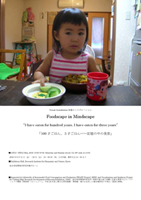Visual Installation
Foodscape in Mindscape
“I have eaten for hundred years, I have eaten for three years”

How the experience of eating is narrated and memorized? Observing the eating as habitus in the life world, problem of memory and subjectivity of eating emerges. How the experience of eating remains in his or her memory is one of the fundamental elements how he or she eats now in the present. Even after a century, a centenarian can remember what he ate in his childhood vividly in detail. Based on the field work in Okinawa and Kyoto, in this installation, the interview and “food-scape” of 100-year-old gentleman and 3-year-old lady is showed and provide an entry point for the coming discussion.
| Date & Hours: | Friday, May 11 - Friday, May 18, 2018, 10:00 - 16:30 *Saturday and Sunday closed. On 18th ends at 14:30. |
| Venue: | Exhibition Hall, RIHN( →Access) |
| Support: | Lifeworlds of Sustainable Food Consumption and Production (FEAST Project), Research Institute for Humanity and Nature Synthesis Project for Cutting Edge Research Development of Museum Exhibition, NIHU. |
| Language: | Japanese with English subtile |
| Remarks: | Reservation not required |
| Contact: | Masahiro Terada  |
| Movies Exhibited: |
|
|---|---|
| Artist: |
Masahiro Terada Visiting Associate Professor of history and meta-history of the Research Institute for Humanity and Nature, Kyoto. Visual works: Die Kindheit in Koke, Color DVD, 2005; A Passage to Shantiniketan, Color DVD, 2016. Publication: Catastrophe and Time: Memory, Narrative and the Energeia of History, Kyoto: Kyoto University Press, 2018, in Japanese; What You Are Waiting for On the Top of the Volcano, or Towards a New ‘‘Scienza Nuova’ of Humanity and Nature, Showado: Kyoto, 2015,in Japanese. |
|
Documentation photo of exhibition: 


|
|

